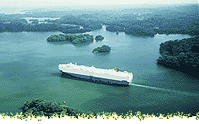 |
 |
 |
|
|||
|
Navigating the Panama Canal When the 81 foot, steel gates closed at the Miraflores Locks, on the Pacific entrance of the Panama Canal, the ship could barely fit in the lock chamber. In just a matter of minutes, the chamber was filled with water and the ship began to rise. I was aboard the U.S.S. New Jersey, the largest ship to ever transit through the Panama Canal. Late last year, the ship known affectionately as the "Big J", went through the canal for the last time. The most decorated battle ship in U.S. history was being towed from Seattle to Camden, New Jersey where it will become a museum.
That's Captain Federico Coburn. He was one of the pilots assigned to navigate the ship across the waterway. Coburn was carefully directing the tugboat operators to proceed to the next lock chamber.
The Big J's canal transit lasted three days. For cruise ships, it normally takes eight to 10 hours. Eric Espino was the logistics coordinator aboard the ship. He explained the complexity of this particular task.
While we waited to enter the next set of locks, Espino took me on a tour of the mothballed battleship. The dark, narrow hallways, claustrophobic low ceiling and vertical ladders still had a strong stench of gunpowder. I could hear the whispers of men who served on board during World War Two, Korea and Vietnam.
As I resurfaced on deck, I got a warm welcome from the other crew members.
Hanging out with them, I noticed a cruise ship from Norway passing through the opposite side of the locks. I waved to the passengers. They waved back. The ocean liner's starboard was packed with tourists leaning over the railing, searching for that perfect picture and mesmerized by the sweaty canal laborers and rope handlers below.
Once the ship cleared the locks at Pedro Miguel, it was 85 feet above sea level, the height of a seven story building. Then, it began its voyage through the narrowest section of the canal, the Gaillard Cut. During the canal construction in the early 1900s, digging the eight mile-long Gaillard Cut was the most difficult and deadliest task. The mostly-black laborers from the West Indies sliced through the mountains of the continental divide. They used over 60 million pounds of dynamite, hundreds of steam shovels and train cars to carry away the debris. The engineering feat at Gaillard's Cut has never been surpassed. There's a plaque on the side of the highest hill to pay homage to the tens of thousands of workers who died during this construction phase of the Panama Canal. Soon after Gaillard's Cut, we sailed across a huge lake. In the middle, there's an island called Barro Colorado, a bird sanctuary for hundreds of bird species. Then we came upon the last set of locks, Gatun Locks. Here, the "Big J" descended from 85 feet, back to sea level using three lock chambers. From a distance, the Gatun Locks looked like a stepladder. Once we cleared the last one, Captain Coburn and the rest of the crew, released command of the vessel and we all climbed off board. From the Panama Canal, this is Rolando Arrieta for the Savvy Traveler.
|
 | American Public Media Home | Search | How to Listen ©2004 American Public Media | Terms of Use | Privacy Policy |

